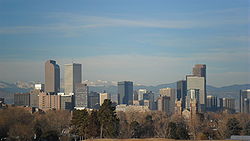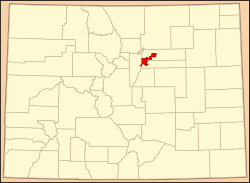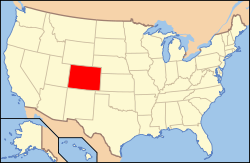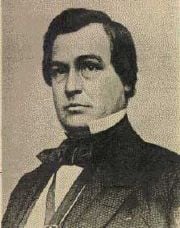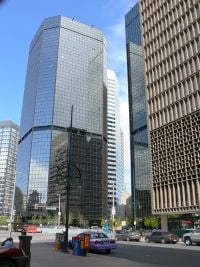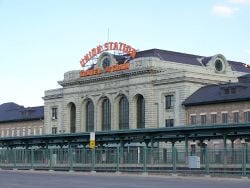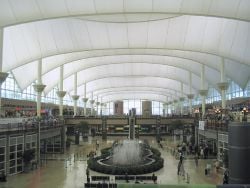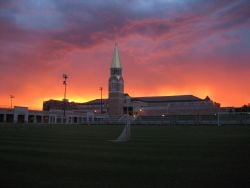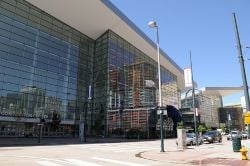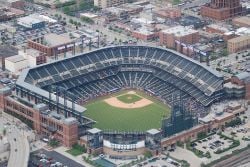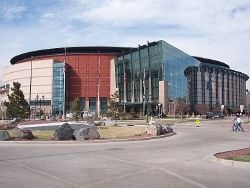Denver, Colorado
| Denver | |||
| — City-county — | |||
| City and County of Denver | |||
| Denver Skyline from City Park, Denver | |||
|
|||
| Nickname: The Mile-High City[1] Queen City of the West, Queen City of the Plains,[2] | |||
| Location of Denver in the State of Colorado | |||
| Location of Colorado in the United States | |||
| Coordinates: 39°44′N 104°59′W | |||
|---|---|---|---|
| Country | United States | ||
| State | Colorado | ||
| City and County | Denver[3] | ||
| Founded | November 22, 1858, as Denver City, K.T. | ||
| Incorporated | 11/7/1861, as Denver City, C.T.[4] | ||
| Consolidated | November 15, 1902, as the City and County of Denver | ||
| Named for | James William Denver | ||
| Government | |||
| - Type | Consolidated City and County[3] | ||
| - Mayor | Michael Hancock (D)[5] | ||
| Area | |||
| - City-county | 154.9 sq mi (401.3 km²) | ||
| - Land | 153.3 sq mi (397.2 km²) | ||
| - Water | 1.6 sq mi (4.1 km²) 1.03% | ||
| - Metro | 8,414.4 sq mi (21,793.2 km²) | ||
| Elevation [6] | 5,130–5,680 ft (1,564–1,731 m) | ||
| Population (2010)[7][8] | |||
| - City-county | 600,158 (US: 26th) | ||
| - Density | 3,874.4/sq mi (1,510.9/km²) | ||
| - Urban | 1,984,887 | ||
| - Urban Density | 3,979.3/sq mi (1,536.4/km²) | ||
| - Metro | 2,552,195 | ||
| - Demonym | Denverite | ||
| Time zone | MST (UTC−7) | ||
| - Summer (DST) | MDT (UTC−6) | ||
| ZIP codes | 80201-80212,80202 80214-80239, 80241, 80243-80244, 80246-80252, 80256-80266, 80271, 80273-80274, 80279-80281, 80290-80291, 80293-80295, 80299, 80012, 80014, 80022, 80033, 80123, 80127[9] | ||
| Area code(s) | Both 303 and 720 | ||
| FIPS code | 08-20000 | ||
| GNIS feature ID | 0201738 | ||
| Highways | I-25, I-70, I-76, I-225, I-270, US 6, US 40, US 85, US 285, US 287, CO 2, CO 26, CO 30, CO 35, CO 83, CO 88, CO 95, CO 121, CO 177, CO 265, CO 470, E-470 | ||
Second most populous Colorado county |
|||
| Website: City and County of Denver | |||
Denver is the capital and the most populous city of Colorado, in the United States. Denver is a consolidated city-county located in the South Platte River Valley on the High Plains just east of the Front Range of the Southern Rocky Mountains. Denver is nicknamed the Mile-High City because its official elevation is exactly one mile, or 5,280 feet (1,609 m), above sea level. It is the second largest city in the Mountain West after Phoenix and has the tenth largest central business district in the United States.
The city embraces its cowboy and mining past and its progressive attitude looks forward with a vibrant arts and performing arts scene, dozens of annual outdoor festivals. More than 200 parks and neighborhoods offer their own unique experiences. Denver offers ready access to the Rocky Mountains, only 15 miles (24 km) to the west.
Denver hosted the 2008 Democratic National Convention, coincidentally on the centennial of the city's hosting of the 1908 Democratic Convention.
In recent years, Denver has set a national precedent for offering services to the homeless, with the creation of a ten-year plan to end homelessness with a dedicated task force and official commission, and an expansion of human and civil services throughout the Denver area.
Geography
Denver is located in the center of the Front Range Urban Corridor, between the Rocky Mountains to the west and the High Plains to the east. The Denver downtown district is located immediately east of the confluence of Cherry Creek with the South Platte River, approximately 15 miles (24 km) east of the foothills of the Rocky Mountains. The densely populated area is beset with smog from its vehicles and factories.
According to the United States Census Bureau, the city has a total area of 154.9 square miles (401.3 km²). The City and County of Denver is surrounded by only three other counties: Adams County to the north and east, Arapahoe County to the south and east, and Jefferson County to the west.
Climate
Denver has a semi-arid climate with four distinct seasons. While Denver is located on the Great Plains, the weather of the city and surrounding area is heavily influenced by the proximity of the Rocky Mountains to the west. The climate, while generally mild compared to the mountains to the west and the plains farther east, can be very unpredictable. Measurable amounts of snow have fallen in the Denver area as late as early June and as early as September. [10]
Denver's winters can vary from mild to cold, and although large amounts of snow can fall on the mountains just west of the city, the city is shielded from precipitation for much of the season. The coldest temperature ever recorded in Denver was -39°F (-39.5°C) in 1875. Spring brings with it significant changes as Denver can be affected by air masses on all sides. Arctic air from the north can often combine with Pacific storm fronts bringing snow to the city. In fact, March is Denver's snowiest month, averaging 11.7 inches (29.7 cm) of snow.
Starting in mid-July, the monsoon brings tropical moisture into the city and with it come frequent short (and occasionally severe) thunderstorms. Despite this tropical moisture, humidity levels during the day generally remain low. In the autumn, the tropical monsoon flow dies down and as Arctic air begins to approach, it can combine with moisture from the Pacific Northwest to bring significant snowfall to the city – November is Denver's second snowiest month, and Denver's greatest recorded snowfall from a single storm, 45.7 inches (116 cm), fell from December 1–6, 1913.[11]
Neighborhoods
The City and County of Denver has defined 79 official neighborhoods that the city and community groups use for planning and administration. These neighborhoods' character vary significantly from each other and include everything from large skyscrapers to modern, suburban-style developments.
Parks and recreation
When Denver was founded in 1858, the city was little more than a dusty collection of buildings on a long, grassy plain with a few contorted cottonwood and willow trees on riverbanks. As of 2006, Denver had over 200 parks, from small mini-parks all over the city to the giant 314-acre (1.3- km²) City Park.[12]
Many of Denver's parks were acquired in the late nineteenth and early twentieth centuries. Denver mayor Robert Speer (1904-1912 and 1916-1918) set out to expand and beautify the city's parks, using landscape architects to design not only parks such as Civic Center Park, but many city parkways. All of this greenery was fed with South Platte River water diverted through the city ditch.[13]
In addition to the parks within Denver itself, the city acquired land for mountain parks beginning in the 1910s. Over the years, Denver has acquired, built, and maintained around 14,000 acres (56 km²) of mountain parks, including Red Rocks Park, which is known for its scenery and musical history revolving around the unique Red Rocks Amphitheatre. Denver also owns the hill on which the Winter Park Resort ski area is operated in Grand County, 67 miles (110 km) west of Denver, and continues to grow its park system with the continuing development of new parks.
Since 1974, Denver and the surrounding jurisdictions have rehabilitated the urban South Platte River and its tributaries for recreational use by hikers and cyclists.
Because of its proximity to the mountains, and generally sunny weather, Denver has gained a reputation as being an outdoor-oriented city. Many Denver residents spend the weekends in the mountains; either skiing in the winter or hiking, climbing, kayaking, and camping in the summer.
The Denver skyline from City Park during a free summer jazz concert
History
Mining town
Denver City was founded in November 1858 as a mining town during the Pikes Peak Gold Rush in what was then the western Kansas Territory. That summer, a group of gold prospectors from Lawrence, Kansas, arrived and established Montana City on the banks of the South Platte River. This was the first settlement in what was later to become the city of Denver. The site was abandoned in favor of Auraria (named after the gold-mining town of Auraria, Georgia) and St. Charles City by the summer of 1859. The Montana City site is now Grant-Frontier Park and includes mining equipment and a log cabin replica.
On November 22, 1858, General William Larimer, a land speculator from eastern Kansas, placed cottonwood logs to stake a claim on the hill overlooking the confluence of the South Platte River and Cherry Creek, across the creek from the existing mining settlement of Auraria. Larimer named the town site Denver City to curry favor with Kansas Territorial Governor James W. Denver. Larimer hoped that the town's name would help make it the county seat of Arapaho County, but ironically Governor Denver had already resigned from office. The location was accessible to existing trails and was across the South Platte River from the site of seasonal encampments of the Cheyenne and Arapaho. The site of these first towns is now Confluence Park in downtown Denver. Larimer, along with associates in the St. Charles City Land Company, sold parcels in the town to merchants and miners, with the intention of creating a major city that would cater to new emigrants. Denver City was a frontier town, with an economy based on servicing local miners with gambling, saloons, livestock and goods trading. In the early years, land parcels were often traded for grubstakes or gambled away by miners in Auraria.
State capital
The Colorado Territory was created on February 28, 1861, Arapahoe County was formed on November 1, 1861,[14] and Denver City was incorporated on November 7, 1861. Denver City served as the Arapahoe County seat from 1861 until consolidation in 1902. In 1865, Denver City became the territorial capital. With its new-found importance, Denver City shortened its name to just Denver. On August 1, 1876, Denver became the state capital when Colorado was admitted to the Union.[14]
Between 1880 and 1895 the city experienced a huge rise in city corruption, as crime bosses worked side-by-side with elected officials and the police to control the elections, gambling, and the bunko gangs. By 1890, Denver had grown to be the second-largest city west of Omaha, but by 1900 it had dropped to third place behind San Francisco and Los Angeles.
In 1901 the Colorado General Assembly voted to split Arapahoe County into three parts: a new consolidated City and County of Denver, a new Adams County, and the remainder of the Arapahoe County to be renamed South Arapahoe County. A ruling by the Colorado Supreme Court, subsequent legislation, and a referendum delayed the creation of the City and County of Denver until November 15, 1902.
Denver was selected to host the 1976 Winter Olympics to coincide with Colorado's centennial celebration, but Colorado voters struck down ballot initiatives allocating public funds to pay for the high costs of the games, so the games were moved to Innsbruck, Austria. The notoriety of becoming the only city ever to decline to host an Olympiad after being selected has made subsequent bids difficult. The movement against hosting the games was based largely on environmental issues and was led by then State Representative Richard Lamm, who was subsequently elected to three terms (1974-1986) as Colorado governor.
Denver has also been known historically as the Queen City of the Plains because of its important role in the agricultural industry of the plains regions along the foothills of the Colorado Front Range.
Law and government
Denver is a consolidated city-county with a mayor elected on a nonpartisan ballot, a 13-member city council and an auditor. The Denver City Council is elected from 11 districts with two at-large council-members and is responsible for passing and changing all laws, resolutions, and ordinances, usually after a public hearing. They can also call for misconduct investigations of Denver's departmental officials.
Denver has a strong mayor/weak city council government. The mayor can approve or veto any ordinances or resolutions approved by the council, makes sure all contracts with the city are kept and performed, signs all bonds and contracts, is responsible for the city budget, and can appoint people to various city departments, organizations, and commissions. However, the council can override the mayor's veto with a nine out of thirteen member vote, and the city budget must be approved and can be changed by a simple majority vote of the council. The auditor checks all expenditures and may refuse to allow specific ones, usually based on financial reasons.[15]
All elected officials have four-year terms, with a maximum of three terms. While Denver elections are non-partisan, Democrats have long held a majority sway on Denver politics. The office of Denver's mayor has been occupied by a Democrat since 1963.
In recent years, Denver has taken a stance on helping people who are or become homeless. Denver's homeless population is considerably lower than many other major cities, but Denver's winters can have brief periods of cold temperatures and varying amounts of snow. As a result, the city has set a national precedent on homeless services, with the creation of a ten-year plan to end homelessness (a plan now becoming popular in other cities), a task force and commission to end homelessness, and an expansion of human and civil services through the Denver area.
In 2005, Denver became the first major city in the U.S. to make the private use of less than an ounce of marijuana legal for adults 21 and older. The city voted 53.49-46.51 percent in favor of the marijuana legalization measure. This initiative does not usurp state law, which currently treats marijuana possession in much the same way as a speeding ticket with fines of up to $100 and no jail time.[16]
Economy
Benefits of geography
Denver's economy is based partially on its geographic position and its connection to some of the major transportation systems of the country. Because Denver is the largest city within 600 miles (1,000 km), it has become a natural location for storage and distribution of goods and services to the Mountain States. Denver is also approximately halfway between the large cities of the Midwest, like Chicago and St. Louis, and the cities of the West Coast, another benefit for distribution. Over the years, the city has been home to other large corporations in the central United States, making Denver a key trade point for the country.
Geography also allows Denver to have a considerable government presence, with many federal agencies based or having offices in the Denver area. In fact, the Denver-Aurora Metropolitan Area has more federal workers than any other metropolitan area except for the Washington, D.C. metropolitan area. Along with the plethora of federal agencies come many companies based on U.S. defense and space projects, and more jobs are brought to the city by virtue of its being the capital of Colorado. The Denver area is home to the former nuclear weapons plant Rocky Flats and the National Renewable Energy Laboratory.
In 2005, a $310.7 million expansion for the Colorado Convention Center was completed, roughly doubling its size. The hope was that the center's expansion would elevate the city to one of the top ten cities in the nation for holding a convention.[17]
Denver's geographic location also benefits the telecommunications industry by allowing communication with both North American coasts, South America, Europe, and Asia in the same business day. Denver's elevation also enables it to be the largest city in the U.S. to offer a "one-bounce" real-time satellite uplink to six continents in the same business day. Qwest Communications, Dish Network Corporation, Starz-Encore, DIRECTV, and Comcast are just a few of the telecommunications companies with operations in the Denver area.
These and other high-tech companies had a boom in Denver in the mid to late 1990s. In 2008, employment rose for all industries except financial services and manufacturing.
Metro Denver’s unemployment rate averaged 4.9 percent through the first nine months of 2008, compared to 3.8 percent in the same months of 2007.[18] The downtown region has seen increased real estate investment with the construction of new skyscrapers.
Mining and energy
Denver's position near the mineral-rich Rocky Mountains encouraged mining and energy companies to spring up in the area. In the early days of the city, gold and silver booms and busts played a large role in the economy of the city. In the 1970s and early 1980s, the energy crisis in America created an energy boom in Denver. When the price of oil dropped from $34 a barrel in 1981 to $9 a barrel in 1986 the Denver economy dropped with it, leaving almost 15,000 oil industry workers in the area unemployed.[19] Energy and mining are still important in Denver's economy, with companies such as EnCana, Halliburton, Smith International, Rio Tinto Group, Newmont Mining, Noble Energy, and Anadarko.
Additionally, Denver and the surrounding cities are home to a large number of local and national breweries. Many restaurants in the region have on-site breweries, and some of the larger brewers, including Coors and the New Belgium Brewing Company, offer tours.
Transportation
Mass transportation
Mass transportation throughout the Denver-Aurora metropolitan area is managed and coordinated by the Regional Transportation District (RTD). RTD operates more than 1,000 buses serving over 10,000 bus stops in 38 municipal jurisdictions in eight counties around the Denver-Aurora and Boulder Metropolitan Areas. Additionally, RTD operates six light rail lines with a total of 34.9 miles (56 km) of track, serving 36 stations.[20] FasTracks is a light rail expansion project approved by voters in 2004, which would serve neighboring communities.
Denver's early years as a major train hub of the West are still very visible today. Trains stop in Denver at historic Union Station, where travelers can access RTD's 16th Street Free MallRide or use light rail to tour the city. Union Station will also serve as the main juncture for rail travel in the metro area, at the completion of FasTracks.
Airports
Denver International Airport, commonly known as DIA, serves as the primary airport for a large region surrounding Denver. DIA is the tenth busiest airport in the world and ranks fourth in the United States, with 47,324,844 passengers passing through it in 2006.[21] It covers more than 53 square miles (137 km²), making it the largest airport by land area in the United States and larger than the island of Manhattan.[22]
Education
Denver Public Schools (DPS) is the public school system in Denver. It currently educates about 73,000 students in 73 elementary schools, 15 K-8 schools, 17 middle schools, 14 high schools, and 19 charter schools[23]. The first school of what is now DPS was a log cabin that opened in 1859 on the corner of 12th Street between Market and Larimer Streets. The district boundaries are coextensive with the city limits.
Denver's many colleges and universities range in age and study programs. The city has Roman Catholic and Jewish institutions, as well as a health sciences school. In addition to those schools within the city, there are a number of schools located throughout the surrounding metro area. The private University of Denver and Johnson & Wales University, Catholic (Jesuit) Regis University and the three public schools that constitute the Auraria Campus are likely the best known higher education institutions located in the city itself.
Demographics
The population of the City and County of Denver was 588,349 on July 1, 2007, making it the 26th most populous U.S. city. The five-county Denver-Aurora Metropolitan Statistical Area had an estimated 2007 population of 2,464,866 and ranked as the 21st most populous U.S. metropolitan statistical area, and the 12-county Denver-Aurora-Boulder Combined Statistical Area had an estimated 2007 population of 2,998,878 and ranked as the 17th most populous U.S. metropolitan area. The 18-county Front Range Urban Corridor had an estimated 2007 population of 4,166,855.
According to census estimates, the City and County of Denver contained approximately 566,974 people in 2006 and 239,235 households in the year 2000. The population density was 3,698/sq mi (1,428/km²). There were 268,540 housing units in 2005 at an average density of 1,751/sq mi (676/km²).[24]
The racial make up of the city, as of 2007, was 50.71 percent white, 10.1 percent African American, 1.3 percent Native American, 3.6 percent Asian American, 0.12 percent Pacific Islander, 14.96 percent from other races, and 1.9 percent from two or more races.[25] Recent Census figures show that 34.4 percent of the population is Hispanic or Latino of any race, giving Denver one of the highest populations of Hispanics or Latinos in the United States.[24] The Chinese ethnic group make-up of the city area is approximately 3.4 percent with a population around 15,600.[26] 11.3 percent were of German, 7.2 percent Irish, and 6.2 percent English ancestry according to the 2000 census. About 73.2 percent spoke English and 21.1 percent Spanish as their first language.
Culture and contemporary life
Denver is home to many nationally recognized museums, including a new wing for the Denver Art Museum, the second largest performing arts center in the nation after Lincoln Center in New York City, and bustling neighborhoods filled with art galleries, restaurants, bars, and clubs.
While Denver may not be as recognized for musical prominence as other American cities, it still manages to have an active pop, jazz, jam, folk, and classical music scene. Well-known folk artists such as Bob Dylan, Judy Collins, and John Denver lived in Denver in the 1960s and 1970s and performed at local clubs.
Colorado has a history steeped in ranching and livestock production. Denver was once a major trading center for beef and livestock; ranchers from all around the High Prairie would drive (or later transport) cattle to the Denver Union Stockyards for sale. As a celebration of that history, each year for more than a century, Denver hosts the National Western Stock Show. The "stock show" as the locals say, is the largest event of its kind among agricultural, western American lifestyle and cultural events in the world, attracting as many as 10,000 animals and 700,000 attendees. The National Western Stock Show is held every January at the National Western Complex, which is located on the northeast edge of downtown.
The Dragon Boat Festival in July, Moon Festival in September, and Chinese New Year are annual events in Denver for the Chinese and Asian residents. Denver also hosts two of the largest Hispanic celebrations in the nation, known to locals as Cinco de Mayo, occurring in May, and El Grito de la Independencia, which takes place in September.
Sports
Denver is home to many sports teams and belongs to a select group of U.S. cities with teams from four major sports. The Denver Broncos of the NFL have been able to draw crowds of nearly 70,000 since their AFL origins in the early 1960s and continue to draw fans today to their current home Invesco Field at Mile High Stadium. The team has advanced to the Super Bowl six times and won back-to-back in 1998 and 1999. In the 1980s and 1990s, one of the top priorities of former Mayor Federico Peña was bringing major league baseball to the city, an effort which culminated in the construction of Coors Field and the creation of the Colorado Rockies as an expansion franchise in 1993. In 2007, their late-season winning streak saw them advance to and win the National League Championship Series and bring the World Series to Denver for the first time. Denver is also home to the Colorado Avalanche, a National Hockey League team that relocated from Quebec City in 1995. They play at Pepsi Center, which also hosts the Denver Nuggets of the National Basketball Association.
Looking to the future
Indicators suggest Metropolitan Denver’s economy will perform below potential in the near term, but local trends – including commercial real estate and local company growth – will nonetheless remain stronger than national averages, according to data compiled by the Metro Denver Economic Development Corporation in its Monthly Economic Summary for November 2008.[27]
Greenprint Denver outlines a series of goals that target key natural resources needing immediate action, along with long-term objectives that are focused around Denver Parks and Recreation's Master Plan. This strategic document calls for a canopy of drought-resistant street trees to cool neighborhoods, cleanse the air, and establish a network of public spaces where residents can walk to enjoy a vibrant urban landscape and healthy ecosystem. Conserving water resources and maintaining clean waterways are also part of Denver's plan to become an environmentally friendly city. The city's fleet of vehicles is increasingly relying on alternative fuels to reduce air pollution.[28]
Notes
- ↑ Claims to Fame – Geography, Epodunk.
- ↑ Queen City, Time (magazine), January 30, 1928. Retrieved April 14, 2012.
- ↑ 3.0 3.1 Active Colorado Municipalities. State of Colorado, Department of Local Affairs. Retrieved November 16, 2007.
- ↑ Colorado Municipal Incorporations. State of Colorado, Department of Personnel & Administration, Colorado State Archives (December 1, 2004). Retrieved December 5, 2007.
- ↑ Interim Mayor Vidal to be sworn in Jan. 12. Denver Post. Retrieved January 17, 2011.
- ↑ Elevations and Distances in the United States. United States Geological Survey (April 29, 2005). Retrieved November 22, 2010.
- ↑ Factfinder2.census.gov. Factfinder2.census.gov (October 5, 2010). Retrieved September 3, 2011.
- ↑ Error on call to template:cite web: Parameters url and title must be specified.
- ↑ ZIP Code Lookup (JavaScript/HTML). United States Postal Service (August 18, 2007). Retrieved October 16, 2007.
- ↑ NOAA National Weather Service. Denver/Boulder, CO Normals and Means 1971-2000 Retrieved November 30, 2008.
- ↑ NOAA National Weather Service. Denver's Winter/Cold Season Statistics Retrieved November 30, 2008.
- ↑ City and County of Denver. Denver Parks & Recreation Retrieved November 30, 2008.
- ↑ Carolyn Etter and Don D. Etter. 2006. City of parks: the preservation of Denver's park and parkway system. (Denver, CO: Denver Public Library. ISBN 9780942214024)
- ↑ 14.0 14.1 State of Colorado, Colorado State Archives. April 18, 2001. State Government History Retrieved November 30, 2008.
- ↑ City and County of Denver. How Denver City Government Works Retrieved November 30, 2008.
- ↑ Patrick O'Driscoll. November 3, 2005. Denver votes to legalize marijuana possession. USATODAY.com. Retrieved November 30, 2008.
- ↑ Kris Hudson. November 24, 2008. Finally, it's built. Now for the test The Denver Post. Retrieved November 30, 2008.
- ↑ Metro Denver Economic Development Corporation. October 2, 2007. Monthly Economic Summary Retrieved November 30, 2008.
- ↑ The City and County of Denver. Denver: The Rocky Mountain Metropolis History. Retrieved November 30, 2008.
- ↑ RTD Denver. Light Rail Retrieved November 30, 2008.
- ↑ Kelly Yamanouchi, October 15, 2007, DIA ranks fourth-busiest Denver Post. Retrieved November 30, 2008.
- ↑ World Airports Council. Largest Airports Retrieved November 30, 2008.
- ↑ Denver Public Schools. Denver Public Schools Facts & Figures Retrieved November 30, 2008.
- ↑ 24.0 24.1 U.S. Census Bureau. Denver County, Colorado QuickFacts Retrieved December 1, 2008.
- ↑ John Sopinski, Numbers tell tale of a city Rocky Mountain News. Retrieved December 1, 2008.
- ↑ Coriell Institute for Medical Research. HapMap Retrieved December 1, 2008.
- ↑ MetroDenver Economic Development Corporation. Monthly Economic Summary for November 2008 Retrieved December 1, 2008.
- ↑ City and County of Denver. Greenprint Denver Retrieved December 1, 2008.
ReferencesISBN links support NWE through referral fees
- Barth, Gunther Paul. Instant cities: urbanization and the rise of San Francisco and Denver. New York: Oxford University Press, 1975. ISBN 0195018990
- Etter, Carolyn, and Don D. Etter. City of parks: the preservation of Denver's park and parkway system. Denver, CO: Denver Public Library, 2006. ASIN B002TYXTKI
- Morley, Judy Mattivi. Historic preservation & the imagined West: Albuquerque, Denver, & Seattle. Lawrence: University Press of Kansas, 2006. ISBN 978-0700614776
- Somervill, Barbara A. Colorado. New York: Children's Press, 2008. ISBN 978-0531185704
External links
All links retrieved January 29, 2024.
- City and County of Denver website
- Denver Public Library
- Denver Public Schools
- City Mayors' profile of John Hickenlooper, Mayor of Denver
- Colorado Historical Society
- Overview of Downtown Denver growth and development
Credits
New World Encyclopedia writers and editors rewrote and completed the Wikipedia article in accordance with New World Encyclopedia standards. This article abides by terms of the Creative Commons CC-by-sa 3.0 License (CC-by-sa), which may be used and disseminated with proper attribution. Credit is due under the terms of this license that can reference both the New World Encyclopedia contributors and the selfless volunteer contributors of the Wikimedia Foundation. To cite this article click here for a list of acceptable citing formats.The history of earlier contributions by wikipedians is accessible to researchers here:
The history of this article since it was imported to New World Encyclopedia:
Note: Some restrictions may apply to use of individual images which are separately licensed.
